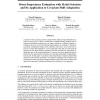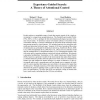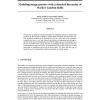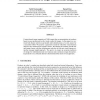106
click to vote
NIPS
2007
15 years 2 months ago
2007
A situation where training and test samples follow different input distributions is called covariate shift. Under covariate shift, standard learning methods such as maximum likeli...
NIPS
2007
15 years 2 months ago
2007
Recent research has studied the role of sparsity in high dimensional regression and signal reconstruction, establishing theoretical limits for recovering sparse models from sparse...
NIPS
2007
15 years 2 months ago
2007
Current computational models of bottom-up and top-down components of attention are predictive of eye movements across a range of stimuli and of simple, fixed visual tasks (such a...
NIPS
2007
15 years 2 months ago
2007
NIPS
2007
15 years 2 months ago
2007
We present an efficient generalization of the sparse pseudo-input Gaussian process (SPGP) model developed by Snelson and Ghahramani [1], applying it to binary classification pro...
53
Voted
NIPS
2007
15 years 2 months ago
2007
NIPS
2007
15 years 2 months ago
2007
Brain-Computer Interfaces can suffer from a large variance of the subject conditions within and across sessions. For example vigilance fluctuations in the individual, variable ta...
NIPS
2007
15 years 2 months ago
2007
We present a probabilistic approach to language change in which word forms are represented by phoneme sequences that undergo stochastic edits along the branches of a phylogenetic ...
NIPS
2007
15 years 2 months ago
2007
Content-based image suggestion (CBIS) targets the recommendation of products based on user preferences on the visual content of images. In this paper, we motivate both feature sel...
NIPS
2007
15 years 2 months ago
2007
Neural spike trains present challenges to analytical efforts due to their noisy, spiking nature. Many studies of neuroscientific and neural prosthetic importance rely on a smooth...




